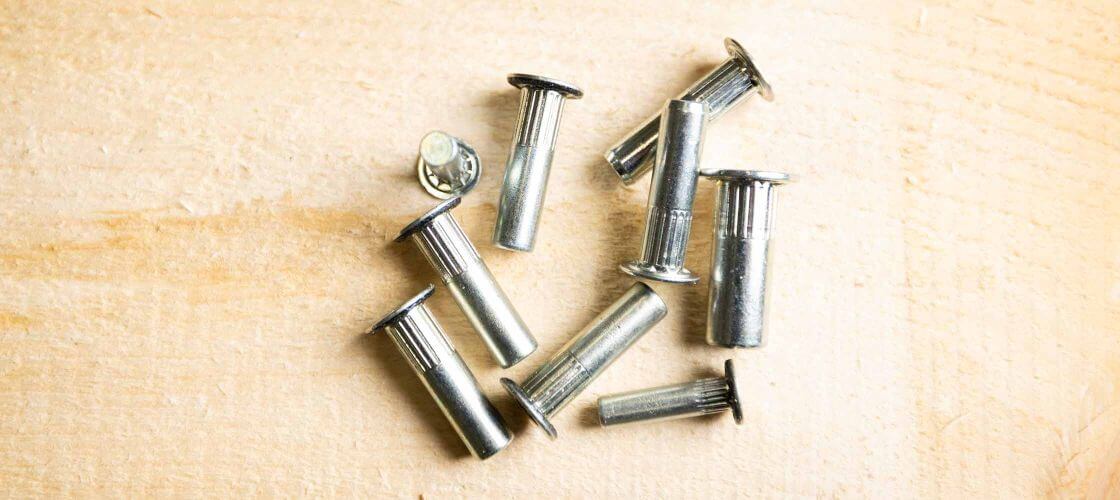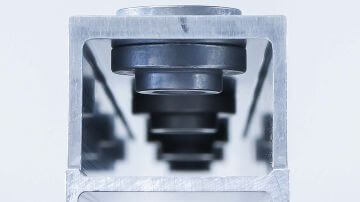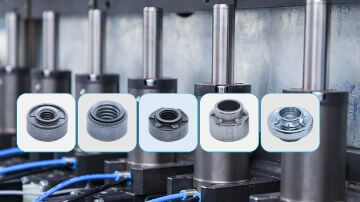
Gas-tight and waterproof fasteners
Rivet nuts, blind rivet nuts and spacers with sealing function
Blog post | december 4, 2023
In the age of electromobility, gas-tight and waterproof fasteners are becoming increasingly important. They are essential for the safety and reliability of electrical components. They are used in battery housings, charging infrastructures and electronics housings, among other applications. Fasteners with a sealing function help to extend the service life of these components and improve the performance of the overall system. They ensure the integrity and safety of systems where leaks could have catastrophic results. They thus also make a significant contribution to the safety and longevity of electric vehicles.
Contact us
Our customer service will help you with any questions!
Contents
- Importance of gas-tight and water-tight connections
- Function of sealing fasteners
- Types of fasteners with sealing function
- Seals and sealing materials of blind rivet nuts
- Selection of a sealing fastener
- Summary
Importance of gas-tight and water-tight connections
The gas-tight and waterproof properties of fasteners are essential for applications that require complete tightness. Water- and gas-tight fasteners create an effective joint that also protects against moisture, oil and contaminants under high pressure.
Riveting fasteners such as closed rivet nuts, spacers, as well as sealing blind rivet nuts and blind rivets ensure a reliable seal.
In battery systems, they protect sensitive components that could be damaged by the ingress of liquids or air. These sealing fasteners are also ideal for applications in tanks, airtight chambers, air conditioning systems and hydraulic systems. Here they ensure that no liquids or gases can penetrate or escape to the outside through the connection.

Function of sealing fasteners
Rivet nuts and blind rivet nuts are used to securely join components together. Due to their closed form, they simultaneously prevent liquids, gases or other substances from escaping or penetrating. Their task is to ensure a permanent tight connection between parts to prevent leakage and maintain the efficiency and safety of the overall system.
Rivet nuts and blind rivet nuts are designed to be used in hard-to-reach places or with thin materials.
This is particularly useful when there is access to the material from only one side, for example in hollow sections or pipes. Rivet nuts can be installed in applications with one-sided accessibility by means of a spin-pull process.
These fasteners are an effective solution when assembling metal profiles, composites or plastics, and also provide threading in soft and brittle materials. They can be used in a wide variety of systems and equipment, from automobiles and aircraft to industrial machinery, piping systems, household appliances and medical devices.

Types of fasteners with sealing function
Closed rivet nuts
Closed rivet nuts provide a strong threaded base for screws. The heavy-duty structural connection is created by deformation of the fastener's rivet collar. They prevent the ingress of liquids and gases by their tight fit or separately applied seals. Rivet nuts are particularly useful in demanding industrial applications where high load capacity and durability are required. They are mainly made of steel or stainless steel and offer very high tensile and shear strength.
Closed blind rivet nuts
Closed blind rivet nuts are installed in thin or hollow materials to create threads for screws. They provide a sealing function by tightly enclosing the material, preventing the ingress of fluids. They may have an injection-molded gasket or an O-ring. Blind rivet nuts are made from materials such as aluminum and steel. Their surface can be galvanized, nickel-plated or untreated. Aluminum blind rivet nuts are lightweight and provide an airtight seal, ideal for aircraft construction. Steel blind rivet nuts are more robust and are therefore suitable for higher-load connections.
Closed spacers / standoffs
Closed spacers are used to distance components. They are usually made of steel or stainless steel, or of an insulating material such as plastic. Due to their closed form, they create an optimal seal. They are used, for example, as insulators in electric vehicle batteries to prevent positive and negative electrodes from coming into contact. Zinc-nickel plating is a common surface coating, especially when steel and aluminum are chemically separated.
Sealing blind rivets
Sealed blind rivets in closed form also completely seal the opening, preventing the ingress of fluids. They are made of aluminum, steel, stainless steel and brass. Their surface can be galvanized, nickel-plated, anodized or untreated. Brass blind rivets resist corrosion by salt water, which is why they are often used in boats. Copper and galvanized steel blind rivets provide additional corrosion protection. Monel, an alloy of nickel and copper, is also common and particularly resistant to corrosion.

Seals and sealing materials of blind rivet nuts
Various seals are used for closed blind rivet nuts. They are located on the under-head side of the blind rivet nut and ensure a secure form fit with the component during setting. They are resistant to many types of higher viscosity fluids, including automotive oils and antifreeze, and can be made of various sealing materials.
Seals are designed to provide a reliable sealing under a variety of operating conditions, including high temperatures, pressure and contact with chemicals. A common form of seal is the injecton-molded gasket. It is usually made of materials such as polyurethane or other synthetic polymers.
Another method of sealing is the use of an O-ring placed underneath the flange.
Rubber is a very commonly used sealing material due to its high flexibility and sealing performance. Rubber gaskets can be manufactured in a variety of shapes and sizes to ensure a perfect fit for any blind rivet nut. PTFE (polytetrafluoroethylene) is another high performance material. It has excellent chemical resistance and can be used at very high temperatures.

Selection of a sealing fastener
When selecting the right sealing fastener, you should consider several criteria. First of all, the material into which the fastener is inserted is of key importance. Here you should also consider the thickness of the material and the general requirements for tightness.
Material of the fastener
The material of the fastener should match the material of the component. It should be corrosion resistant to ensure a long service life. Choosing the right combination of materials is critical to avoid galvanic corrosion. Galvanic corrosion occurs when two different metals come into contact and cause an electrochemical reaction. This results in damage to one of the metals.
Combinations such as aluminum and copper should therefore be avoided. Instead, you could opt for a material that offers better resistance to corrosion, such as galvanized steel. Additionally, certain material combinations can improve the temperature resistance of the fastener.
Load capacity
The fastener should also have the required load capacity. It should be able to withstand the forces that occur when the components are connected. In addition, you should consider the tensile strength of the fastener selected and the pressure it must withstand.
Size and shape
The size and shape of the fastener must meet the requirements of the component. The fastener should not be too large or too small to ensure a secure connection. The diameter is critical because it determines the size of the pilot hole required. Therefore, a diameter that is too large may result in an unstable connection, while a diameter that is too small may make installation more difficult later on.
Grip range
For blind rivet nuts, the grip range must be taken into account. This refers to the thickness of the material that the blind rivet nut is designed to hold. The type of seal used on blind rivet nuts - whether it's an O-ring or an injection-molded seal - also plays a role. The resistance of the seal to various fluids and temperature should be considered here.
Application area
Finally, the specific application area of the fastener must be considered. Some fasteners are better suited for certain applications than others. The design of the closed fastener should therefore be carefully considered. It is also recommended to perform application tests under specific project conditions to evaluate the performance of the fastener.

Summary
Closed fasteners play a crucial role in applications requiring a gas-tight or waterproof connection. They provide a secure and robust connection, especially in materials unsuitable for thread forming. They are especially useful in applications where liquids and gases must not escape or penetrate.
Sealing fasteners such as closed rivet nuts, blind rivet nuts and spacers are versatile, from cars and aircraft to boats and pumps.
Selecting the right material, whether aluminum or steel, is critical to the performance and longevity of the joint.
Look for a suitable design and load capacity of the fastener to ensure a durable seal. However, keep in mind that certain combinations of materials should be avoided due to the risk of corrosion.






